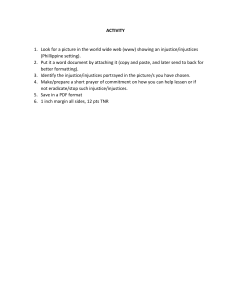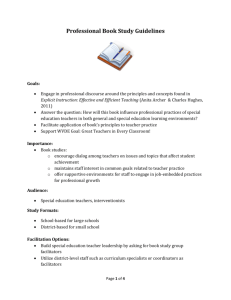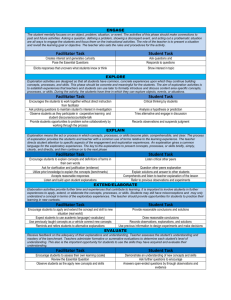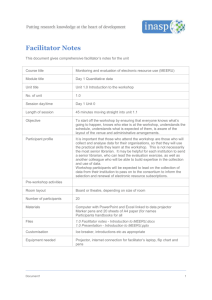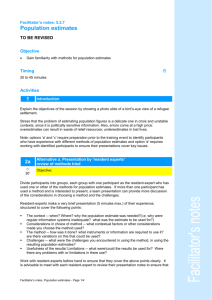Facilitating Conflict Resolution
advertisement
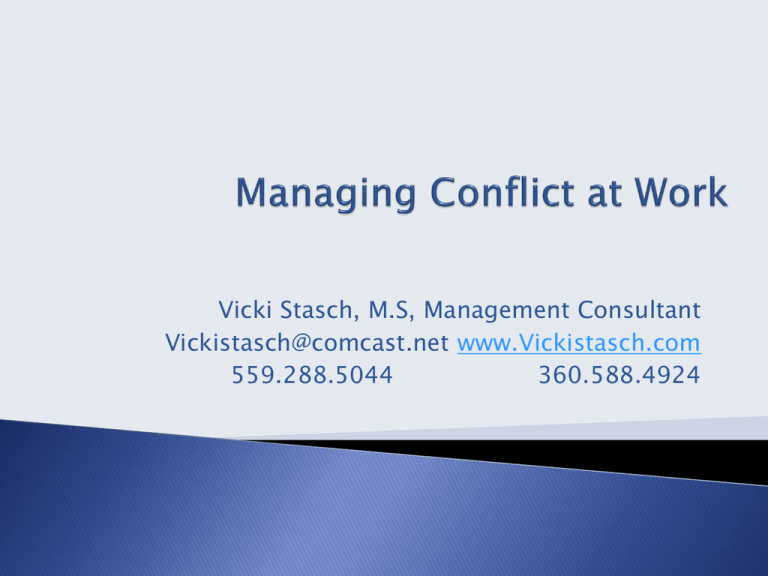
Vicki Stasch, M.S, Management Consultant Vickistasch@comcast.net www.Vickistasch.com 559.288.5044 360.588.4924 Over 30 years as a facilitator for team building, strategic planning, leadership development and other work to create positive work environments Facilitator for year-long leadership development programs in California and Whatcom County Clients include state and local government, non profits, businesses, health care Education: B.A. University of Washington, M.S. from University of San Francisco Hobbies and interests: rowing, bicycling, tap dancing, Rotary International, environmental issues and others Overview of Conflict and Management Principles Methods for handing conflict Specific steps to follow Opportunity to develop a strategy to handle a current conflict Danger Opportunity Something to avoid Something else Conflict is when a least one person (group) is being blocked or feels he or she is being blocked from doing or getting something they want. Misunderstanding- lack of role clarity Personality clashes- not liking another person Competition for resources ($, people, time) Authority issues Lack of cooperation Differences over methods or style Low performance Value or goal differences Others_________________________ What types of conflict challenges you the most at work? What are the route causes? A. I like to win-I am competitive B. I tend to avoid difficult conflicts C. I tend to choose my battles and may give in D. I strive to reach a compromise if possible Ignoring things that bother you is shown in your body language and voice tone. Control your response. Count to 10 or walk away until you cool down. Talk or write to the person asking for a time to meet If someone approaches you with a problem, be willing to work on it If “A” complains about “B” who is not present, encourage “A” to go directly to ”B”. Do not spread the message If you try working on the issues with no resolution seek a third party facilitator Remember, on a bad day you are almost never alone! Close your eyes and smile at least once a day! Change/confusion/tension: best time to address conflict unless we avoid or say “not a big deal” 2) Role dilemma: Questions about what’s going on, begin the blame game 3) Injustices collecting: collect injustices, negative energy. Injustice takes place of original confusion 4) Confrontation: at unexpected time; judging or condemning the other rather than focusing on the issue 5) Adjustments: distance ourselves (psychologically or physically). Continued accommodation or dominance 1) Is this a real problem or are you having a bad hair day Identify the real issue, not symptoms or personalities Be prepared to work toward a “win-win” not “winning” Use Covey’s “Seek First to Understand then to be Understood” method Having a bad hair day? #1: One person holds power over the other and tells the solution #2: Arbitration: Third party solution, like judge in a courtroom or a policy manual #3: Mediation: two people resolve with a third party facilitator #4: Cooperative: Two people resolve together A. B. C. D. An employee is perpetually late for work. After several discussions, the supervisor tell the employee “one more time and you are fired” Two workers cannot agree on an assignment and ask their supervisor to clarify it with them Two co workers agree to go to lunch with each desiring different food. They decide to go to restaurant A this week and B next week. Two managers disagree over how the sexual harassment policy should be applied. They ask HR for clarification and read the company policy manual. Listening attentively ◦ Paraphrasing ◦ Openness ◦ Stating agreement Speaking assertively ◦ “I” messages ◦ Stating preferences Write or envision a few words that describe a conflict that is bothering you. Determine which of the methods 1,2,3,or 4 is appropriate. Develop a strategy including the words you will use to address the conflict after we review the recommended steps. Describe the conflict: __________________________________________ __________________________________________ __________________________________________ ______________________ Which strategy- 1,2,3,or 4 is most appropriate_______________________ Looks like we have a problem (rather than “you” have a problem). I’d like to resolve this problem using method #4 (show the 4 methods). Do you wish to start, do you wish me to start or should we toss a coin? When someone complains about another “Is this a problem you would like to get resolved” then offer to facilitate. Invitation: Is each person willing to work fairly and cooperatively using the steps below following options #3 or #4? ( If not, should #1 or # 2 be used?) 1) 2) Basic rules: ◦ Allow (name of person) to lead the process ◦ Listen without interrupting ◦ Be honest as you can ◦ No name calling or profanity ◦ Be willing to summarize ◦ If process seems unfair, say so Person A: Describe how you experienced the problem, conflict or injustice. Person B: summarizes (“you said that…..?” Person B: Describe how you experienced the problem, conflict or injustice Person A : summarizes (“you said that….?) Have the experiences been recognized? If not repeat ◦ 4) Seek agreements that: Restore equity: How can you make things as right as possible now?” Clarify future: “ How can you prevent this from happening again?” ◦ 5) Summarize agreement and congratulate: Write an agreement, give copy to each person and congratulate. Set follow-up meeting. If no agreement return to step #1 ◦ 6) Follow up: Are agreements being kept? If yes, celebrate. If not, repeat process. Describe the conflict from early in presentation: ___________________________________________ ___________________________________________ ___________________________________________ ___________________ Describe the method you will use to seek resolution ___________________________________________ ___________________________________________ ___________________________________________ ___________________________________________ _____________ R espect the right to disagree E xpress your real concerns S hare common goals and interests O pen yourself to different points of view L isten carefully to all proposals U nderstand the major issues T hink about probable consequences I magine several possible alternative solutions O ffer some reasonable compromise N egotiate mutually fair cooperative agreements Vicki Stasch
